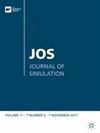设计可持续性项目以避免和逃脱能力陷阱
IF 1.7
4区 工程技术
Q4 COMPUTER SCIENCE, INTERDISCIPLINARY APPLICATIONS
引用次数: 0
摘要
本文章由计算机程序翻译,如有差异,请以英文原文为准。
Designing sustainability programs to avoid and escape the capability trap
ABSTRACT The capability trap relegates organisations to poor performance by preventing feedback loop dominance shifts from working harder to working smarter. Escaping the trap is difficult because of the feedback structure that creates the trap, managerial biases, and delays in exploiting high leverage solutions. Previous research analysed cases of existing systems captured by or escaped from the trap, primarily to identify and explain trapping mechanisms. The current work approaches different by investigating how systems can be designed a priori to avoid or better escape the trap. We modeled a sustainability improvement program that successfully avoided capture and identified escape scenarios. The simulation model analysis identified high leverage improvement design features for trap avoidance and escape. Building efficiency features such as energy-saving effectiveness, decreasing life-cycle costs, increasing improvement lifespans, and conservation effectiveness influence performance. Improvement program design guidelines to escape or avoid the trap are proposed, and future research opportunities are discussed.
求助全文
通过发布文献求助,成功后即可免费获取论文全文。
去求助
来源期刊

Journal of Simulation
COMPUTER SCIENCE, INTERDISCIPLINARY APPLICATIONS-OPERATIONS RESEARCH & MANAGEMENT SCIENCE
CiteScore
5.70
自引率
16.00%
发文量
42
期刊介绍:
Journal of Simulation (JOS) aims to publish both articles and technical notes from researchers and practitioners active in the field of simulation. In JOS, the field of simulation includes the techniques, tools, methods and technologies of the application and the use of discrete-event simulation, agent-based modelling and system dynamics.
 求助内容:
求助内容: 应助结果提醒方式:
应助结果提醒方式:


